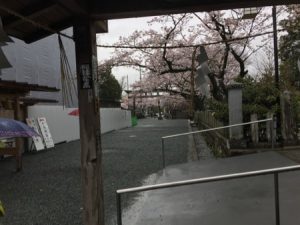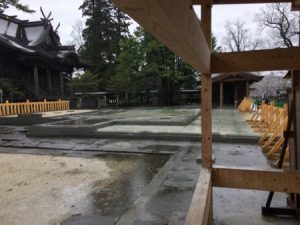At the weekend, I went to visit Aso Jinja, in Kumamoto Prefecture, in Kyushu. Aso Jinja is the Ichinomiya for the old Higo Province, and one of the oldest jinja in Japan. The family of the chief priests goes back over a thousand years, as does the jinja itself. There are twelve main kami enshrined at the jinja, who form a family, and the family of the chief priests is said to be descended from the oldest of these kami. These days, its main benefit is said to be safe travel, but it is also associated with water, due to vigorous springs in the area, and agriculture, because just about every jinja is associated with agriculture. The jinja is located within the caldera of volcano; technically, within the caldera of an active volcano, although most of the caldera, which is about 25 km across, is not active these days. The central peak within the caldera is, however, still active.

The earthquake has made it slightly more difficult to get there than it used to be, as both the railway and some of the roads were blocked, and have not yet reopened. I went by train, by Shinkansen to Kyushu, and then changing to local trains, because I don’t like flying, and because it is necessary to go the long way around, it took about nine hours. Thus, I stayed overnight near the jinja, in an extremely nice, and not ridiculously expensive, ryokan called Aso no Shiki (The Four Seasons of Aso).
The following morning, it was raining, so as I walked to the jinja, I could only barely make out the mountain wall of the caldera through the clouds and mist. At the jinja itself, I went to the office, and filled in the form to ask for a kigansai, to pray for the recovery of the area.

After the ceremony, I had the chance to talk to one of the priests. Actually, he came to talk to me, because he recognised my name. According to him, they expect it to take four or five years to rebuild the prayer hall. The tower gate was an Important Cultural Property, however, which means that it has to be rebuilt very carefully. At the moment, it is covered by a temporary white building, and I believe that, inside, it is being carefully taken apart, so that it can be rebuilt as close as possible to the original, with as much of the original material as possible. The priest said that it might take as long as ten years to rebuild the gate.
I would like to go back to the jinja, to see how the rebuilding is progressing, and also to see the scenery in Kyushu again; what I could see through the rain was beautiful.
If you are interested in knowing a bit more about the religious background to this jinja, I am writing a series of essays about Shinto, supported on Patreon. I hope they are of interest.